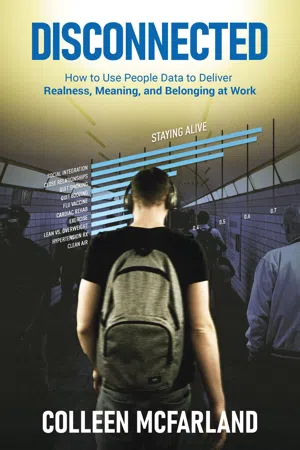
This is a test
- English
- ePUB (mobile friendly)
- Available on iOS & Android
eBook - ePub
Book details
Book preview
Table of contents
Citations
About This Book
Did you know technology has not only changed how we work, but the youngest workers, too?
Gen Z is bringing a tech savviness and a need for security to work. Read Disconnected to better understand what welcome mat is needed to engage and win the affection of the youngest workers.
In Disconnected, you'll discover:
- Why online experiences matter more than game rooms
- How to satisfy and direct iGen's constant need to learn
- What people data is and why the time is now to leverage it
Read Disconnected and build realness, meaning and belonging in your workplace.
Frequently asked questions
At the moment all of our mobile-responsive ePub books are available to download via the app. Most of our PDFs are also available to download and we're working on making the final remaining ones downloadable now. Learn more here.
Both plans give you full access to the library and all of Perlego’s features. The only differences are the price and subscription period: With the annual plan you’ll save around 30% compared to 12 months on the monthly plan.
We are an online textbook subscription service, where you can get access to an entire online library for less than the price of a single book per month. With over 1 million books across 1000+ topics, we’ve got you covered! Learn more here.
Look out for the read-aloud symbol on your next book to see if you can listen to it. The read-aloud tool reads text aloud for you, highlighting the text as it is being read. You can pause it, speed it up and slow it down. Learn more here.
Yes, you can access Disconnected by Colleen McFarland in PDF and/or ePUB format, as well as other popular books in Commerce & Gestion des ressources humaines. We have over one million books available in our catalogue for you to explore.
Information
Part ONE
chapter 1
Provide employees their people data

Richard keeps his feet firmly planted as his train car moves steadily over the bridge. He looks east out the window at the river. His eyes strain to see if they can spot Lake Michigan. The grip of his left hand is loose on the strap attached to the ceiling. His right hand is gripped tight around his iPhone.
The latest Barstool podcast is playing in his AirPods. His smartphone vibrates. He turns his gaze to his phone and sees a news alert, it’s another deadly mass shooting: five people killed at a bank in Florida. With his free hand he scrolls his Instagram. He smiles at a jab given to his friend Charlie by his brother Joe. He checks his bank app to see if his direct deposit has shown up yet.
The train slows to a crawl and the riders begin jostling toward the door. The recorded announcement blares: “Washington is next. The doors open on the right. Please keep your belongings off the seat next to you so others may sit down.”
The train stops. “This is Washington.” The doors open. Richard makes his way slowly to the door and exits along with most of the others on the train car, careful to make no eye contact with any of them.
Richard is afraid of failure. Yet, if you met him when he’s wearing his tailored suit and easy smile, you would not see this. He’s polished, likable, and carries himself with an air of confidence as he walks the streets of the Chicago Loop. However, since he started his dream job last month, at a prestigious financial institution, he has been filled with self-doubt.
This day he gets his Starbucks coffee then settles into his desk. He opens an email from his Human Resources partner. It states that his Integrated Wellbeing information has been updated and is available through his People Data Dashboard. The email states that the Integrated Wellbeing information is collected by a third party and is confidential. It has a link. Richard clicks the link and is taken to a screen full of colorful charts, graphs and tables titled “Richard’s People Data.” As he scans the page, he can tell the information is about him.
His eyes bounce around as he takes in the page. He sees the details from his resumé and what looks like the results of a test he took while interviewing. His eyes stop at a chart with four quadrants titled “Your Wellbeing Indicator.” He scrolls over the title and reads, “Your Wellbeing Indicator measures your current wellbeing in physical, emotional, social, and financial terms; it identifies areas of strength and high performance, and helps you pinpoint where you need to focus to build your wellbeing, productivity, and overall business performance and track progress over time. These are the results of your most recent Health Assessment Survey.” Richard recalls taking a survey when he selected his health benefits the day he started.
The quadrant titled “social wellbeing” is bright red. He sees in the chart’s key that the “red” signifies this score is low and action is recommended. He sees a bolded link that reads “action options” underneath the wellbeing chart. He clicks this link. Then a bright yellow page opens. Its title is “Social Wellbeing.”
Richard scans the section and comes to understand that social wellbeing is about being connected to others and applies both to the workplace and your personal life. It requires skills related to having stronger relationships like knowing how to support and collaborate with others, being able to successfully resolve conflicts, and adapt to change.
On the screen he sees suggested videos, articles, and support services related to social wellbeing. He decides to look this over when he gets home. He closes the screen and goes back to his inbox.
Later that evening, after polishing off his dinner, he opens his laptop and navigates to back to his People Data Dashboard and the bright yellow “action options” section. He watches some videos and reads some articles that explain that action is needed. Those with low social wellbeing scores—like his—will find themselves with declining physical wellbeing and emotional wellbeing if no action is taken. He comes to understand that wellbeing facets are related to one another. Richard sees he needs to address his low “social wellbeing” score. He reviews the support options and determines that of the support services offered he likes the wellbeing coach option most. They can meet over the phone, or on a web app like Skype.
He also likes that wellbeing coaches usually refrain from giving direct advice or solving their client’s problems—rather, they ask questions and guide. Plus, he’s wondering if the coach will help him to understand his self-doubt problem too.
He requests the wellbeing coaching services and the next day receives an instant message from Terry, the coach. They make plans to meet over Skype the following week, before Richard heads off to work.
After three months of coaching support, Richard takes a follow-up Health Assessment. He can tell as he answers the questions that he has made progress. After the last question, he presses submit. He’s then directed to the chart that compares the survey he just completed to the one he took earlier. He can see the progress clearly. The social wellbeing score is no longer red. It’s now yellow, which means he still has work to do but is progressing. He closes the report and makes a mental note to look it over that night.
Provide each employee an individualized People Data Dashboard
Having data to show progress on wellbeing will motivate your employees to work at being well—especially if you customize the support offerings. One way to provide the wellbeing data is through an individualized people data dashboard, like the one just described.
Wellbeing data is one type of people data. People data is also known as employee data. It’s defined as datasets describing people in organizations. It is the information you have available on your various pools of people, collected from any one of your systems such as Human Resources Information System.
Included in an employee’s dashboard could be all the people data you have on that individual. Including the sets of data that will be addressed in this book:
• Wellbeing: Annual health assessment data.
• Performance: Current and past performance reviews.
• Professional Development: Current and past development plans.
• Engagement: Company engagement survey data and individual data and teams data.
• Operations: Activity from operation and business processes. For example, data from video meetings, phone calls, ...
Table of contents
- PREFACE
- INTRODUCTION—THE TIME IS NOW TO USE PEOPLE DATA
- HOW TO READ THIS BOOK
- Part ONE
- CHAPTER 1 – PROVIDE EMPLOYEES THEIR PEOPLE DATA
- CHAPTER 2 – EQUIP YOUR MANAGERS
- CHAPTER 3 – BETTER THE ONLINE EMPLOYEE EXPERIENCE
- CHAPTER 4 – DATA PRIVACY AND ETHICS
- PART TWO
- CHAPTER 5 – TYPES OF PEOPLE DATA
- CHAPTER 6 – WELLBEING DATA
- CHAPTER 7 – ENGAGEMENT DATA
- CHAPTER 8 – PERFORMANCE DATA
- CHAPTER 9 – PROFESSIONAL DEVELOPMENT DATA
- CHAPTER 10 – OPERATIONS DATA
- PART THREE
- CHAPTER 11 – USING PEOPLE DATA
- CHAPTER 12 – DETECT PROBLEMS. PROMOTE SAFETY
- CHAPTER 13 – ANSWER QUESTIONS. REAFFIRM
- CHAPTER 14 – TEST SOLUTIONS. SOLVE PROBLEMS
- CHAPTER 15 – TARGET OUTREACH
- CHAPTER 16 – IGNITE GOAL SETTING. MONITOR PROGRESS
- CONCLUSION
- EPILOGUE
- ACKNOWLEDGEMENTS
- APPENDIX